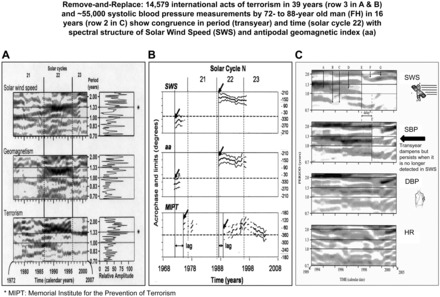Fig. 13.

Just as removal and replacement of a gland led to endocrinology, so biological consequences of the loss of environmental spectral components are critical to chronomics, the study of chronomes (time structures) in and around us. The drifting, bi- or trifurcation, disappearance and reappearance of a component with a given frequency and, when present, the waxing and waning of its amplitude, visualized in A and C, is in keeping with external driving of an individual (C) and of a population (A and B). Note components with neighboring frequencies waxing at or near a transyear component in SWS (A, top; and C, top), geomagnetism (A, 2nd row), and in 39 yr of terrorist activity (A, bottom), an association supported by an independent method in B by the statistical significance of the fit of a 1.3-yr far-transyear to interplanetary (SWS) and terrestrial (aa) magnetism and to terrorism. Analysis in A is “glocal” insofar as it is based on the entire series in the spectral window on the right (global) and in sections of the series in the gliding windows on the left (local). Analyses only on sections of the time series are local in B (complementing the global counterpart, as seen on the right of A) and local in C. C shows time courses of the frequency structures of SWS (top) and of an elderly man's (F.H.) SBP, DBP, and HR; SBP, DBP, and HR (rows 2–4, respectively), examined by gliding spectral windows. Human SBP selectively resonates with SWS (top 2 sections). No obvious resonance, only minor coincidence of apparent change, is seen by some in DBP or HR (bottom 2 sections). Aeolian rhythms in gliding spectra of SWS and SBP change in frequency [smoothly (A) or abruptly (B–D), bifurcating (D and F), and rejoining (G); they also change in amplitude (B) up to disappearing (C and E) and reappearing]. *Memorial Institute for the Prevention of Terrorism (MIPT).
